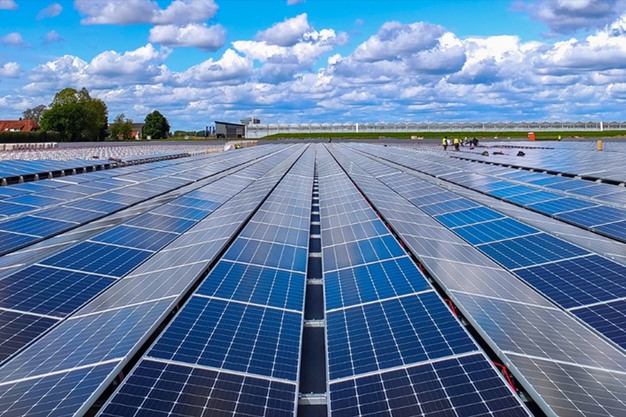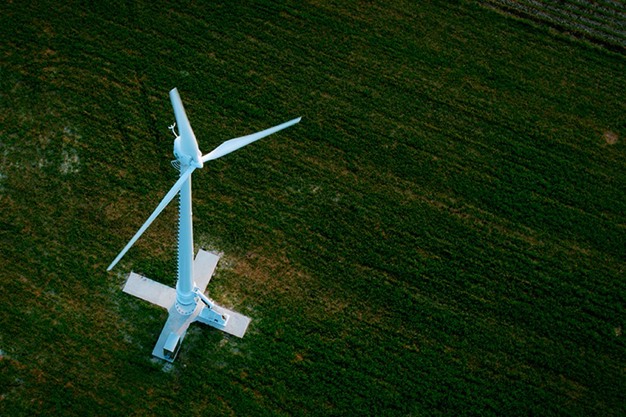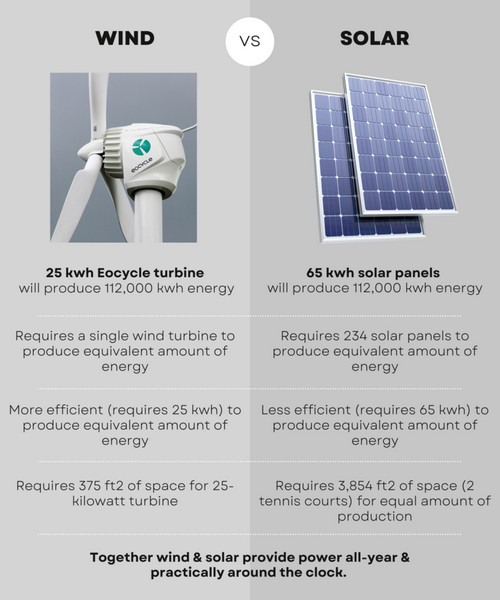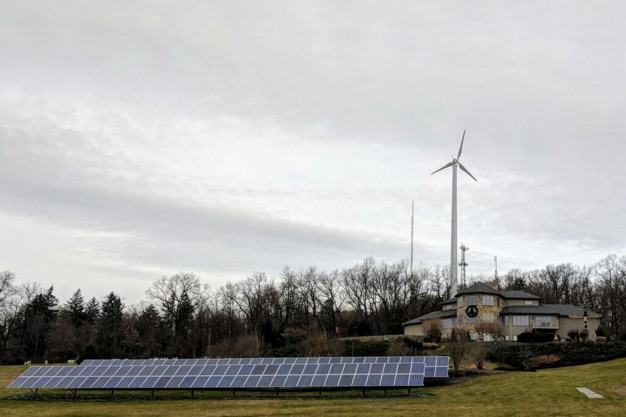Choosing to power your commercial farm with renewable energy is an excellent way to save money and lessen your carbon footprint. Two types of technologies that dominate the renewable energy category are wind and solar. While both technologies offer their own advantages, specific factors like your budget, land availability, and available financial incentives will determine which solution is more advantageous to you (hint: it could be both). The following article by Ceres Greenhouse Solutions will help you navigate this decision.
When deciding on wind versus solar for your greenhouse operation or commercial farm, you should consider the following:
- What types of solar panels or wind turbines are available for your use?
- What are the cost comparisons?
- What are the comparative outputs for each?
- How much space do you have available for system installation?
- What is the end-of-life recycling process and capabilities for spent solar panels or wind turbines?
Before delving into each of these questions, it's important to highlight that if your goal is to achieve net-zero food production using renewable energy (producing as much energy with renewables as needed to operate your farm), opting for an energy-efficient greenhouse can significantly reduce your energy consumption and, consequently, the initial investment in solar or wind equipment. "While we will specifically outline energy examples for Ceres greenhouses, it's worth noting that our structures demand considerably less energy to operate compared to conventional greenhouses or indoor cultivation setups," the company says.
What types of solar panels and wind turbines are available for commercial farms?
For commercial use, there are several types of solar panels available, each with its own advantages and suitability for different applications.
Monocrystalline panels offer high efficiency and space efficiency, making them ideal for maximizing energy production in limited space.
Polycrystalline panels are less expensive but generally have lower efficiency rates, suitable for applications where upfront cost is a significant factor.
Thin-film panels are lightweight and flexible, often used in situations where traditional panels may be unsuitable due to weight or installation constraints, albeit with lower efficiency.
Bifacial panels capture sunlight from both sides, enhancing energy production, while building-integrated photovoltaics (BIPV) seamlessly integrate solar panels into building materials for aesthetic and functional benefits. 
When selecting solar panels for commercial use, factors such as efficiency, space requirements, upfront cost, durability, and aesthetics should be considered, with consultation from solar energy professionals recommended for tailored solutions. As for wind turbines, Ceres partner, Eocycle, offers two main series: the S-Series and the M-Series.
The S-Series is designed for small to medium-scale wind energy projects, featuring models with capacities ranging from 25 to 60 kW. These turbines are suitable for commercial operations such as farms, remote communities, and industrial facilities looking to integrate wind power into their energy mix. They are known for their reliability, efficiency, and low operational costs.
On the other hand, the M-Series targets medium to large-scale wind energy projects, with models capable of generating up to 1 MW of power. These turbines are ideal for larger commercial operations, utility-scale projects, and wind farms seeking to maximize energy production and optimize returns on investment. They are engineered to deliver high performance, durability, and grid compatibility, making them well-suited for a wide range of commercial applications.
What are the cost comparisons between solar and wind energy?
When comparing the costs of solar and wind energy, it's essential to consider federal incentives that can significantly impact the overall investment. For wind turbine buyers, Eocycle can connect farmers with various federal incentives that can substantially reduce the initial costs and improve the financial viability of wind energy projects.
The Bonus Depreciation incentive enables the depreciation of 100% of eligible costs of the turbine investment within the first year, with 85% deemed eligible. This incentive allows businesses to recoup a significant portion of their investment upfront, reducing the financial burden.
Additionally, the Investment Tax Credit (ITC) offers credit for 30% of investment costs at the start of the project, further lowering the overall expenditure. Furthermore, the Rural Energy for America Program (REAP) provides grant funding to help rural businesses adopt renewable energy systems, offering up to 50% of total eligible project costs.
These incentives, combined with the financial benefits of Renewable Energy Credits (RECs), which allow corporations to offset carbon emissions by replacing emissions-causing electricity with zero-emissions electricity, contribute to making wind energy projects more financially attractive. RECs are issued for each megawatt-hour (MWh) of renewable electricity generated and delivered to the grid from a renewable energy resource, helping businesses reduce their carbon footprint and meet sustainability goals.
Many of the federal incentives that apply to wind energy projects also apply to solar energy projects, although the specifics may vary slightly. Overall, solar energy has historically had lower initial costs and is more widely adopted. But wind energy is becoming increasingly competitive, particularly in regions with favorable wind resources. Both solar and wind energy play important roles in transitioning to a cleaner and more sustainable energy future.
For a direct dollar-to-kilowatt cost comparison of the two systems, we can look at data from an actual farm in Minnesota that added solar panels to supplement the renewable energy generated by an existing Eocycle wind turbine. The added panels produce 26,000kWh of solar at an installed cost of $95,000, and the Eocycle S-Series produces 83,078kWh with an installed cost of $212,000. The easy math before energy incentives equates to solar being $3.65 per kWh and wind being $2.55 per kWh. 
What are the comparative energy outputs for wind and solar?
To compare the energy outputs for wind versus solar, we can use the information provided about Eocycle's 25kW wind turbine and the equivalent solar panel setup. According to the data, Eocycle's 25kW wind turbine can produce 112,000 kWh annually under specific wind conditions (4m/s average or faster). In contrast, to achieve the same annual energy output with solar power, it would require approximately 65 kW of solar panels, which translates to about 234 panels.
To put this in perspective, Eocycle's S-16 model can generate enough electricity (130,000kWh per year, 130 MWH) to run two 3,000 sq ft Ceres greenhouses. According to Eocycle's calculations, you would need 271 solar panels to achieve the same amount of output.
While each renewable has its strengths in energy production—solar excels during the day, especially from noon to 5, while wind provides a more consistent output throughout the day and night—combining them can yield optimal results. This combination ensures a more reliable and consistent energy supply, practically around the clock and all year round. Wind and solar energy complement each other, with their peaks and lulls often offsetting one another.
Interested farmers can calculate the potential energy output of solar panels at their location using the PVWatts calculator provided by the National Renewable Energy Laboratory. Similarly, they can assess wind energy potential using the Global Wind Atlas. By leveraging both wind and solar resources, farmers can create a resilient and sustainable energy system to power their farms while reducing reliance on traditional energy sources.
How much space is needed for solar panels versus wind turbines?
Considering the calculations in the previous section, to achieve enough energy production to operate two greenhouses, you would need a considerably larger installation footprint on your farm if you were to choose solar energy over wind energy. According to Eocycle, solar requires two tennis courts of land for the same production of their 25kW wind turbine and 10 tennis courts for their 90kW turbine.
Other factors which may impact space requirements for wind and solar power beyond installation footprint include land availability (wind turbines need open, unobstructed areas to harness wind energy effectively, while solar panels can be installed on rooftops or in smaller, confined spaces), spacing between structures, zoning regulations, visual impact, environmental considerations, and scalability. Evaluating these factors is essential for determining the most suitable renewable energy option for a specific location or application.
What is the end-of-life recycling process and capabilities for spent solar panels or wind turbines?
The recycling of used solar panels or wind turbines represents an emerging industry with significant potential to recycle the majority of their component materials. Despite the initial lack of demand for recycling since the early 2000s when PV panels and small wind turbines were initially installed for consumers, there is an increasing recognition of the need for recycling in the coming decades. It is anticipated that the industry will adapt and meet this growing need.
Choosing to power your commercial farm with renewable energy is an excellent decision, both environmentally and economically. As you weigh the options between wind and solar energy, it's crucial to consider factors such as budget, space availability, energy output, and potential incentives. Wind turbines and solar panels each have their strengths and advantages, with wind providing consistent energy production and solar excelling during daylight hours. Combining both can offer a more reliable and comprehensive energy solution, ensuring power practically around the clock and all year round. With current stress on the electrical grid, rising electric costs, and abundant incentives and grants available, there's never been a better time for consumers to invest in renewable energy systems. By harnessing the power of wind and solar, farmers can not only reduce their reliance on traditional energy sources but also benefit from lower operating costs and a cleaner, more sustainable future.
For more information: Ceres Greenhouse Solutions
Ceres Greenhouse Solutions
Email: [email protected]
www.ceresgs.com
